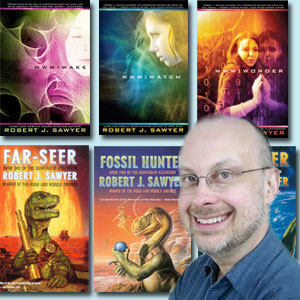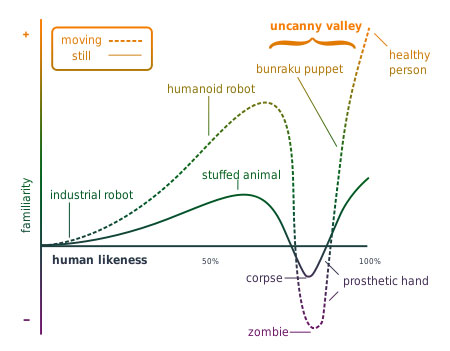 Robert J. Sawyer, award-winning science fiction author, chats with The Genre Traveler about his new series of science fiction thrillers focused on a self-aware Internet. In addition, we chat about common themes in artificial intelligence stories, how the history of the World Wide Web has diverged from the early dystopic literary visions of cyberpunk, what happens when computers become smarter than people, the need for positive visions of artificial intelligence, the uncanny valley, the job of a science fiction writer being the balance between technology cheerleader and luddite … preparing us for possible futures, does placing a year in your fiction set it up for being out dated?, spoiling the surprise ending for newbies because it has become a meme, having his novel Flashforward turned into a TV show, his novel Far-Seer, honorary doctorates, meeting Minnie Jean Brown Turkey Little Rock Nine, and more.
Robert J. Sawyer, award-winning science fiction author, chats with The Genre Traveler about his new series of science fiction thrillers focused on a self-aware Internet. In addition, we chat about common themes in artificial intelligence stories, how the history of the World Wide Web has diverged from the early dystopic literary visions of cyberpunk, what happens when computers become smarter than people, the need for positive visions of artificial intelligence, the uncanny valley, the job of a science fiction writer being the balance between technology cheerleader and luddite … preparing us for possible futures, does placing a year in your fiction set it up for being out dated?, spoiling the surprise ending for newbies because it has become a meme, having his novel Flashforward turned into a TV show, his novel Far-Seer, honorary doctorates, meeting Minnie Jean Brown Turkey Little Rock Nine, and more.
To help defray the cost of hosting the podcast, archived episodes greater than four months old will be made available for sale at $0.99 per episode.
Duration: 34:22
File Size: 39.4 MB
Mentioned in this Episode:
The Three Laws of Robotics
Developed by Isaac Asimov for his robot stories.
- A robot may not injure a human being or, through inaction, allow a human being to come to harm.
- A robot must obey any orders given to it by human beings, except where such orders would conflict with the First Law.
- A robot must protect its own existence as long as such protection does not conflict with the First or Second Law.
| Neuromancer by William Gibson Neuromancer is considered a seminal work in the cyberpunk genre. Gibson earned the science-fiction “triple crown” — the Nebula Award, the Philip K. Dick Award, and the Hugo Award – for the novel. It was his first novel and the beginning of the Sprawl trilogy. Neuromancer tells the story of a washed-up computer hacker hired by a mysterious employer to work on the ultimate hack. |
 Time Magazine’s Person of the Year 2006
Time Magazine’s Person of the Year 2006
For the 2006, Time magazine chose “You” as the person of the year. In its explanation of the choice, it said, the new World Wide Web, being called Web 2.0, was “a tool for bringing together the small contributions of millions of people and making them matter.” It sited sites such as Wikipedia, YouTube and MySpace for helping make this happen. “…for seizing the reins of the global media, for founding and framing the new digital democracy, for working for nothing and beating the pros at their own game, TIME’s Person of the Year for 2006 is you.”
Frankenstein; or, The Modern Prometheus by Mary Shelley
 Mary Shelley started writing Frankenstein when she was 18. The novel was first published anonymously when she was 21 in 1818. A second, revised edition was later published with her name on it. Although many refer to the monster, a re-animated body cobbled together from several corpses, as Frankenstein, the novel never does. Shelley refers to it as Adam and the story uses such terms as “monster,” “fiend,” “wretch,” “vile insect,” “daemon” and “it.” This classic novel has been called the first science fiction novel and is also respected as one of the classic works of horror.
Mary Shelley started writing Frankenstein when she was 18. The novel was first published anonymously when she was 21 in 1818. A second, revised edition was later published with her name on it. Although many refer to the monster, a re-animated body cobbled together from several corpses, as Frankenstein, the novel never does. Shelley refers to it as Adam and the story uses such terms as “monster,” “fiend,” “wretch,” “vile insect,” “daemon” and “it.” This classic novel has been called the first science fiction novel and is also respected as one of the classic works of horror.
 Frankenstein complex
Frankenstein complex
A term coined by Isaac Asimov in his robot stories that means a fear of mechanical men, especially those that most closely resemble humans (androids, gynoids and humaniform robots). To some degree, this fear can also be applied to other forms of artificial intelligence. The concept of the Frankenstein complex is very similar to Masahiro Mori’s uncanny valley hypothesis, which states that when people see human facsimilies, they have an instinctual response of revulsion. The uncanny valley happens along a continuum on increasing closeness to human likeness. As a robot is made to appear more humanlike, people will like it more and more until it reaches a certain point that causes the opposite reaction. However, if you continue toward the more humanlike, the revulsion will, at some point, revert back to positive.

Memes
 A meme is an idea or other element of culture that can be passed on to others through non-genetic means. The term was coined by Richard Dawkins in his book, The Selfish Gene (1976) and was taken from the word “mimeme,” Ancient Greek for “something imitated.” Dawkins used the term to discuss evolutionary principles as they apply in the spreading of non-genetic ideas, behavior and other cultural phenomena, such as catch-phrases (like “my bad”) or technologies (like building arches). In the 1990s, the field of study called memetics arose to examine the transmission of memes. It is somewhat controversial because many believe that you can’t categorize culture into discrete units.
A meme is an idea or other element of culture that can be passed on to others through non-genetic means. The term was coined by Richard Dawkins in his book, The Selfish Gene (1976) and was taken from the word “mimeme,” Ancient Greek for “something imitated.” Dawkins used the term to discuss evolutionary principles as they apply in the spreading of non-genetic ideas, behavior and other cultural phenomena, such as catch-phrases (like “my bad”) or technologies (like building arches). In the 1990s, the field of study called memetics arose to examine the transmission of memes. It is somewhat controversial because many believe that you can’t categorize culture into discrete units.
 Flashforward
Flashforward
The 2009-2010 TV series, Flashforward was adapted from Robert J. Sawyer’s 1999 novel of the same name by Brannon Braga (Star Trek: The Next Generation, Threshold) and David S. Goyer (Blade: The Series, Dark City). The series stared Joseph Fiennes as FBI Special Agent Mark Benford who leads a team to try to uncover the mystery of the flashforward, a time when everyone on the planet went unconscious and saw a few minutes of their own history.
For more information about Robert J. Sawyer:
Related Posts:
- Podcast Episode 10: Can artificial intelligence become self aware?
- Travel Reads: Ygor by Lee Murphy
- Travel Reads: Visions of Tomorrow
- Historic Moments and Observances with a Genre Twist, October 2007
Other Related Articles by Carma
- The Terror and Appeal of the Machine
- SF subgenres: What is dinosaur science fiction?
